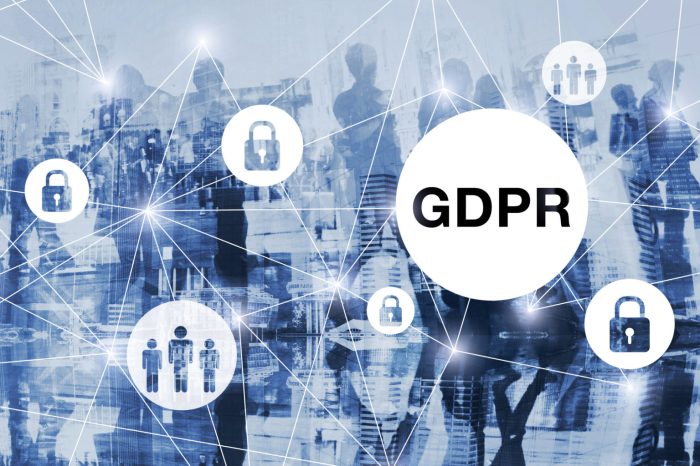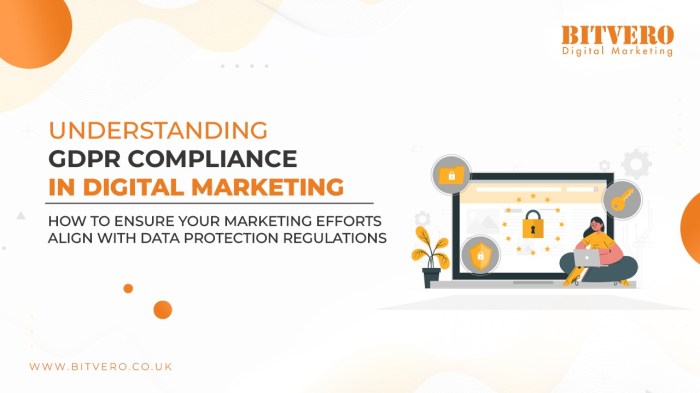Understanding GDPR Compliance sets the stage for a deep dive into the world of data protection regulations, offering insights into the key principles, compliance requirements, and more.
Get ready to unravel the complexities of GDPR and discover how organizations can navigate this regulatory landscape effectively.
Overview of GDPR Compliance
GDPR, which stands for General Data Protection Regulation, is a set of regulations designed to protect the personal data and privacy of individuals within the European Union (EU) and the European Economic Area (EEA). It aims to give control back to citizens and residents over their personal data and simplify the regulatory environment for international business by unifying the regulation within the EU.
Brief History of GDPR Implementation
The GDPR was adopted on April 27, 2016, by the European Parliament and Council, and it became enforceable on May 25, 2018. This regulation replaced the Data Protection Directive of 1995 and has been considered one of the most significant data privacy laws to date.
Main Objectives of GDPR Compliance
- Ensure the protection of personal data of individuals within the EU and EEA
- Regulate the processing of personal data by organizations and businesses
- Empower individuals with more control over their personal data
- Harmonize data protection regulations across the EU
- Impose strict penalties for non-compliance with the regulation
Key Principles of GDPR
The General Data Protection Regulation (GDPR) is built on a set of key principles that aim to protect the personal data of individuals and ensure transparency in data processing. Each principle plays a crucial role in safeguarding the privacy rights of individuals and holding organizations accountable for how they handle data.
Lawfulness, Fairness, and Transparency
- Lawfulness: Personal data must be processed lawfully, meaning there must be a legal basis for collecting and using the data. This principle ensures that data processing activities are conducted within the boundaries of the law.
- Fairness: Organizations must process personal data in a fair and transparent manner, taking into account the rights of the individuals whose data is being processed. This principle emphasizes the importance of treating individuals fairly when handling their data.
- Transparency: Data controllers are required to provide individuals with clear and easily accessible information about how their data is being processed. Transparency helps build trust between organizations and individuals, allowing for informed decision-making regarding data privacy.
Purpose Limitation and Data Minimization
- Purpose Limitation: Personal data should only be collected for specified, explicit, and legitimate purposes. Data controllers must clearly define the purposes for which data is processed and ensure that data is not used for any other purposes without consent.
- Data Minimization: Organizations should only collect data that is necessary for the intended purpose. Data minimization reduces the risk of unauthorized access or misuse of personal data and helps protect individuals’ privacy.
Accuracy and Storage Limitation
- Accuracy: Data controllers are responsible for ensuring that personal data is accurate and kept up to date. Accuracy is crucial in maintaining the integrity of data and preventing the dissemination of incorrect information.
- Storage Limitation: Personal data should be stored for no longer than is necessary for the purposes for which it was collected. Storage limitation helps minimize the risk of data breaches and unauthorized access by limiting the retention period of personal data.
Personal Data Protection under GDPR: Understanding GDPR Compliance
When it comes to personal data protection under GDPR, it is essential to understand what constitutes personal data and the rights individuals have regarding their information.
Definition of Personal Data under GDPR
Personal data under GDPR refers to any information that can directly or indirectly identify a person. This includes but is not limited to names, addresses, email addresses, identification numbers, IP addresses, and biometric data.
Rights of Individuals Regarding Personal Data, Understanding GDPR Compliance
- Right to Access: Individuals have the right to request access to the personal data that organizations hold about them.
- Right to Rectification: Individuals can request that inaccurate or incomplete data be corrected.
- Right to Erasure: Also known as the “right to be forgotten,” individuals can request the deletion of their personal data under certain circumstances.
- Right to Data Portability: Individuals can request to receive their personal data in a commonly used format for transferring to another organization.
- Right to Object: Individuals have the right to object to the processing of their personal data in certain situations.
Examples of Personal Data in Different Contexts
- Healthcare: Medical records, health insurance information, and biometric data.
- Financial: Bank account details, credit card information, and income records.
- Employment: Employee ID numbers, performance reviews, and salary details.
- Online: IP addresses, cookies, browsing history, and social media profiles.
GDPR Compliance Requirements

To comply with GDPR, organizations must adhere to several key requirements to ensure the protection of personal data and privacy of individuals. Failure to comply can result in significant fines and penalties.
Appointment of a Data Protection Officer
Organizations are required to designate a Data Protection Officer (DPO) to oversee GDPR compliance efforts and serve as a point of contact for data protection authorities.
Data Mapping and Inventory
Organizations must conduct a thorough assessment of the personal data they collect, process, and store. This includes documenting the types of data, sources, recipients, and retention periods.
Consent Management
Under GDPR, organizations must obtain explicit consent from individuals before collecting or processing their personal data. Consent should be freely given, specific, informed, and unambiguous.
Data Security Measures
Organizations are required to implement appropriate technical and organizational measures to protect personal data from unauthorized access, disclosure, alteration, or destruction. This includes encryption, access controls, and regular security audits.
Data Subject Rights
GDPR grants individuals certain rights over their personal data, including the right to access, rectify, erase, restrict processing, and data portability. Organizations must have processes in place to facilitate these rights.
Data Breach Notification
Organizations must notify the relevant data protection authority and affected individuals of any data breaches within 72 hours of becoming aware of the incident. Failure to do so can result in severe penalties.
International Data Transfers
Organizations transferring personal data outside the European Economic Area (EEA) must ensure that the data is adequately protected. This may involve implementing standard contractual clauses or other approved safeguards.
Consequences of Non-Compliance
Non-compliance with GDPR regulations can lead to fines of up to 4% of annual global turnover or €20 million, whichever is higher. In addition to financial penalties, organizations risk damage to their reputation and loss of customer trust.
Data Processing and GDPR
In the realm of GDPR compliance, data processing plays a crucial role in how organizations handle personal data. Let’s delve into the concept of data processing under GDPR and explore the lawful bases for processing personal data, as well as how organizations can ensure lawful data processing practices.
Concept of Data Processing under GDPR
Data processing under GDPR refers to any operation or set of operations performed on personal data, such as collection, recording, organization, structuring, storage, adaptation, alteration, retrieval, consultation, use, disclosure by transmission, dissemination, or making available, alignment, or combination, restriction, erasure, or destruction.
Lawful Bases for Processing Personal Data
- Consent: Individuals have given clear consent for their personal data to be processed for specific purposes.
- Contractual Necessity: Processing is necessary for the performance of a contract to which the individual is a party.
- Legal Obligation: Processing is necessary to comply with a legal obligation.
- Vital Interests: Processing is necessary to protect the vital interests of the individual or another person.
- Public Task: Processing is necessary for the performance of a task carried out in the public interest or in the exercise of official authority.
- Legitimate Interests: Processing is necessary for the legitimate interests pursued by the data controller or a third party, except where such interests are overridden by the interests, rights, or freedoms of the data subject.
Ensuring Lawful Data Processing Practices
Organizations can ensure lawful data processing practices by:
- Implementing clear policies and procedures for data processing.
- Obtaining valid consent from individuals before processing their personal data.
- Regularly reviewing and updating data processing activities to ensure compliance with GDPR.
- Providing adequate training to staff members involved in data processing to ensure they understand their responsibilities.
- Encrypting sensitive personal data to protect it from unauthorized access.
GDPR Data Breach Notification
Data breaches are a serious concern under GDPR, and organizations must adhere to specific requirements when reporting such incidents. Timely notification is crucial to ensure the protection of personal data and maintain compliance with the regulations.
Reporting Data Breaches under GDPR
- Organizations are required to report data breaches to the relevant supervisory authority within 72 hours of becoming aware of the breach.
- If the data breach is likely to result in a high risk to the rights and freedoms of individuals, organizations must also inform the affected individuals without undue delay.
- The notification to the supervisory authority should include details of the breach, the categories of personal data involved, the likely consequences of the breach, and the measures taken or proposed to address the breach.
Handling Data Breaches – Step-by-Step Guide
- Identify the Breach: Quickly identify and assess the nature and scope of the data breach.
- Contain the Breach: Take immediate steps to contain the breach and prevent further unauthorized access to personal data.
- Assess the Risks: Evaluate the potential risks to individuals’ rights and freedoms resulting from the breach.
- Notify the Supervisory Authority: Report the breach to the relevant supervisory authority within the specified timeframe.
- Notify Affected Individuals: If the breach poses a high risk, inform the affected individuals without delay.
- Document the Breach: Maintain detailed records of the breach, response actions, and communications for compliance purposes.
Importance of Timely Data Breach Notifications
Timely data breach notifications are essential to protect individuals’ rights and freedoms, allowing them to take necessary precautions to mitigate potential risks. Prompt reporting also enables supervisory authorities to assess the situation, provide guidance, and enforce compliance with GDPR regulations.
GDPR Compliance Tools and Resources

When it comes to GDPR compliance, organizations can utilize various tools and resources to ensure they are meeting the necessary requirements and protecting personal data. These tools can help streamline processes, manage data effectively, and maintain compliance with the regulations.
Common Tools for GDPR Compliance
- Data Mapping Tools: These tools help organizations identify and map out the flow of personal data within their systems, making it easier to track and manage data processing activities.
- Consent Management Platforms: These platforms allow organizations to obtain, track, and manage user consent for data processing in a transparent and compliant manner.
- Data Encryption Software: Encryption tools help protect personal data by securing it during storage and transmission, ensuring data remains confidential and secure.
Resources for Understanding GDPR Regulations
- GDPR Guidelines and Documentation: Official resources provided by the EU offer detailed information on GDPR requirements, best practices, and compliance guidelines.
- GDPR Training Programs: Organizations can enroll in training courses and workshops to educate employees on GDPR principles, data protection, and compliance obligations.
- GDPR Consultation Services: Consulting firms and legal experts can provide guidance and support in interpreting GDPR regulations, implementing compliance measures, and conducting audits.
Comparison of GDPR Compliance Software
| Software | Features | Pricing |
|---|---|---|
| OneTrust | Data mapping, consent management, data subject rights automation | Subscription-based pricing model |
| TrustArc | Data inventory, risk assessment, compliance reporting | Customized pricing based on company size |
| IBM Guardium | Data classification, monitoring, and encryption | Varies based on deployment and services required |